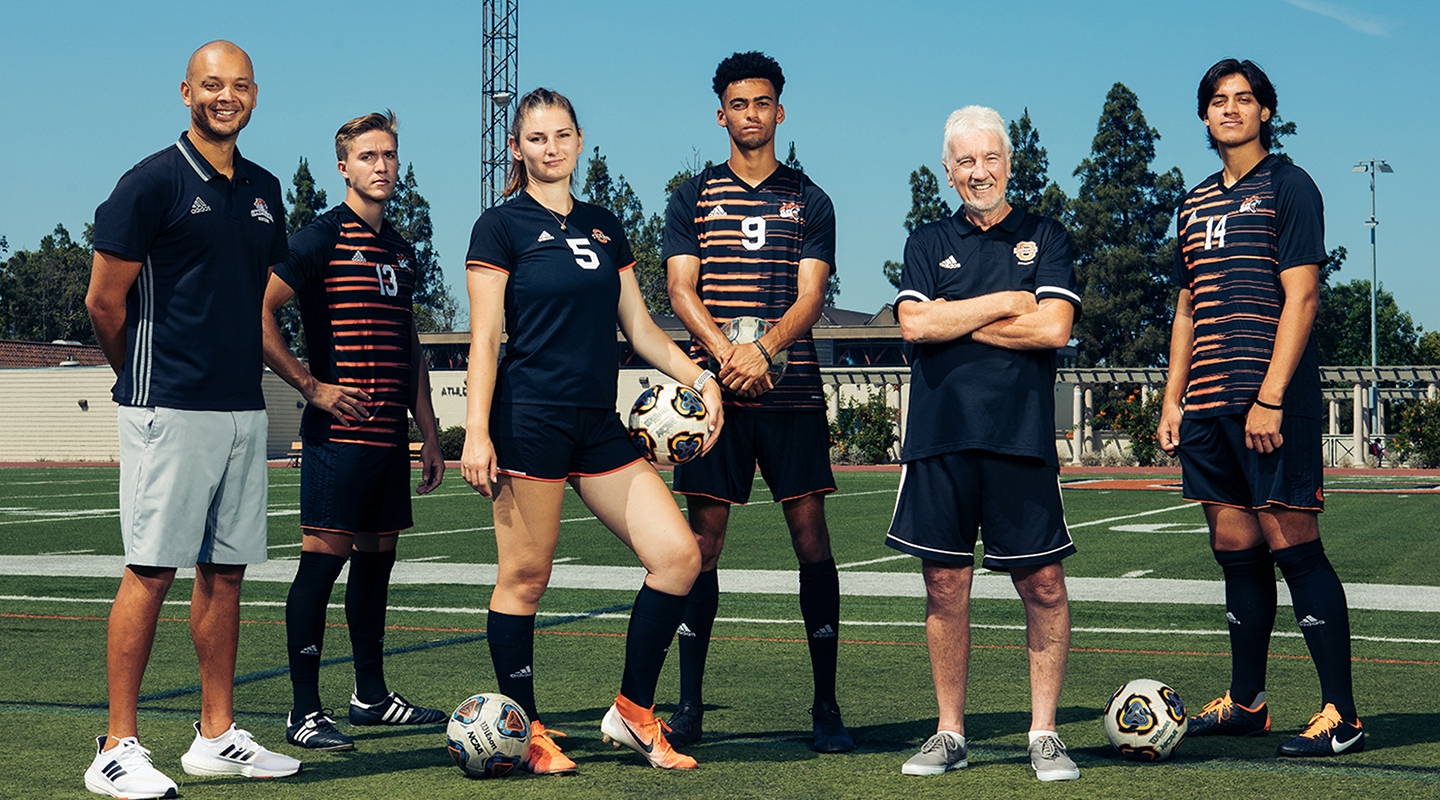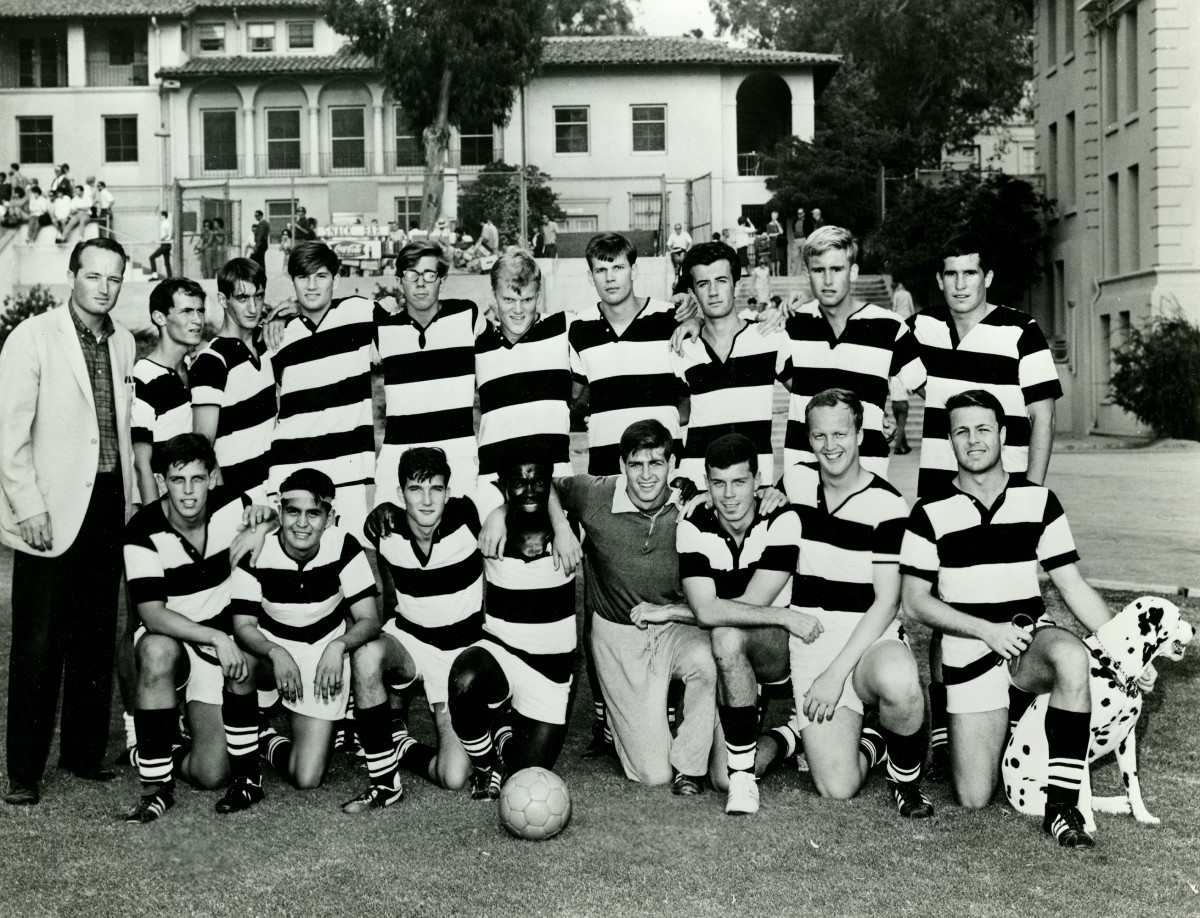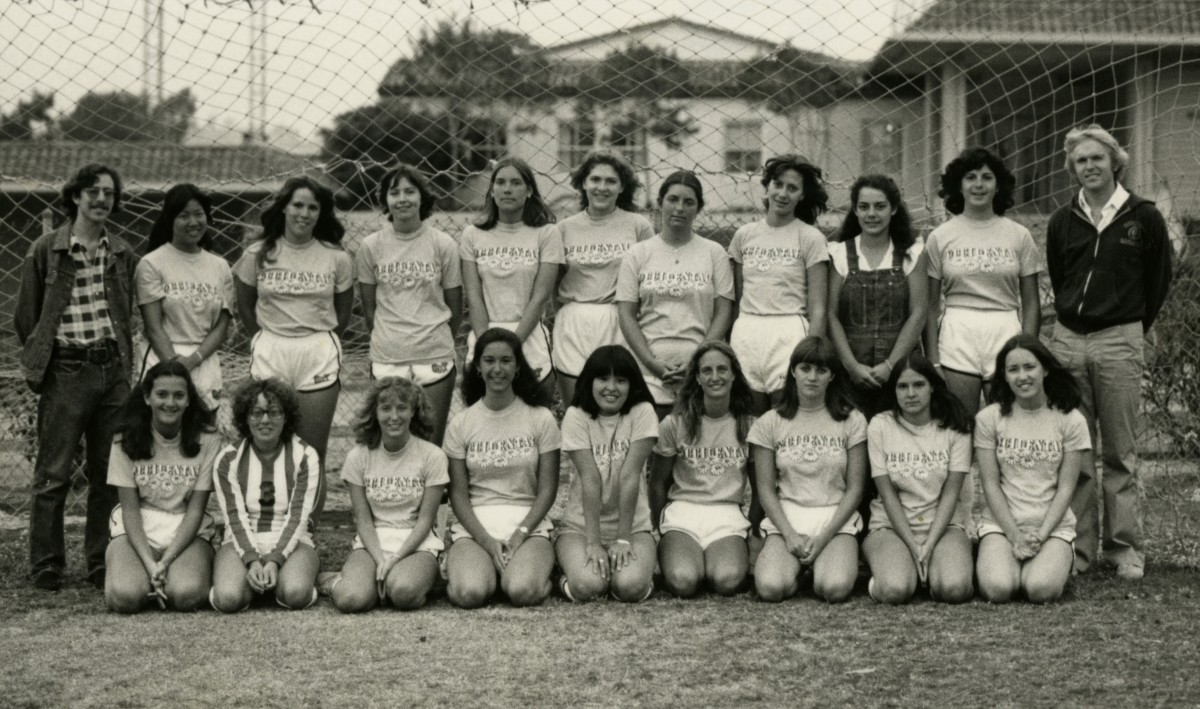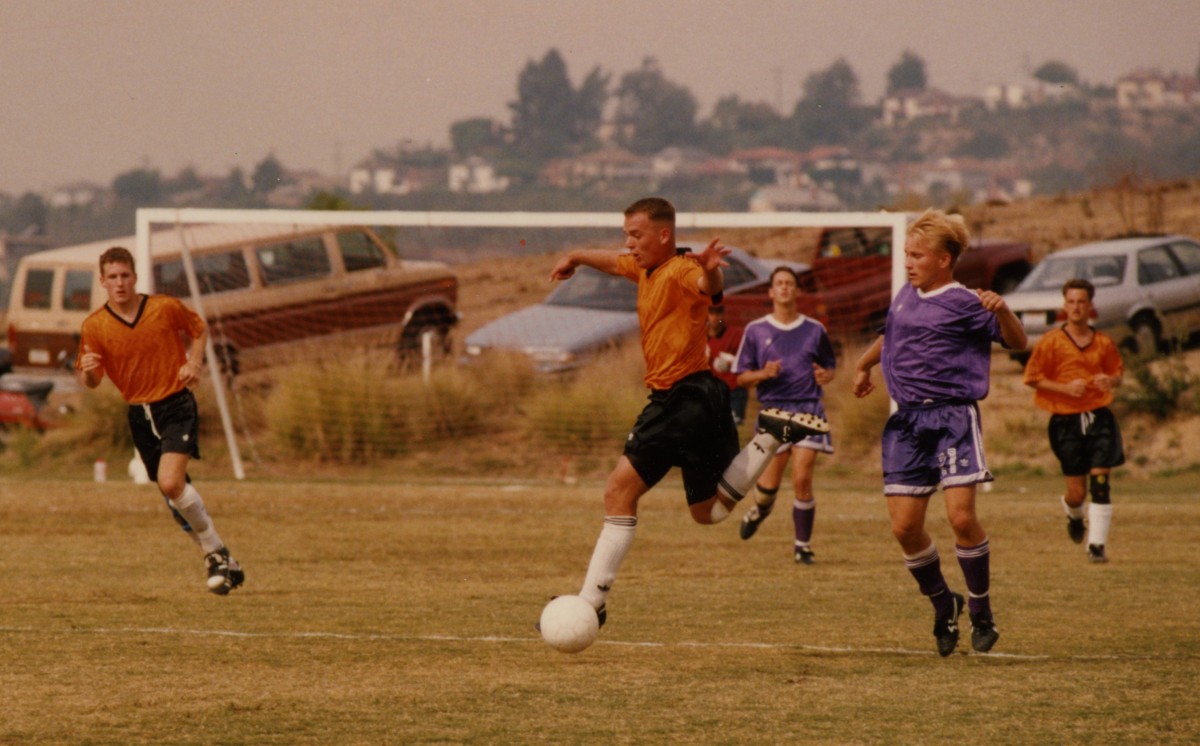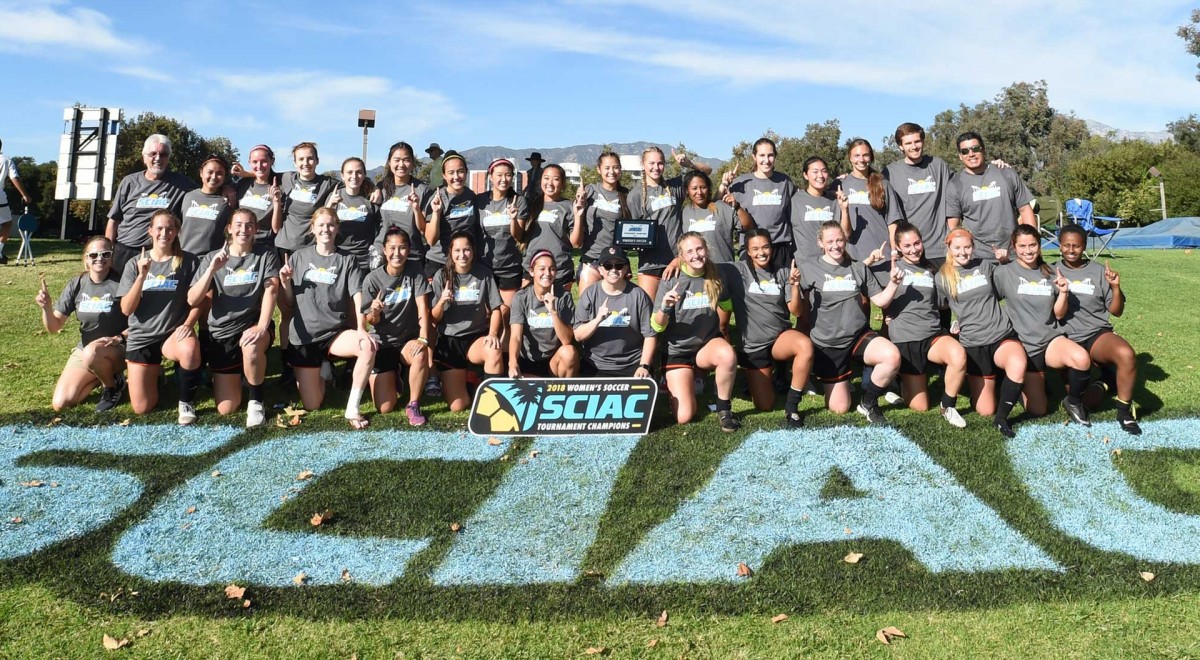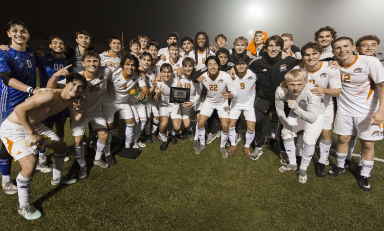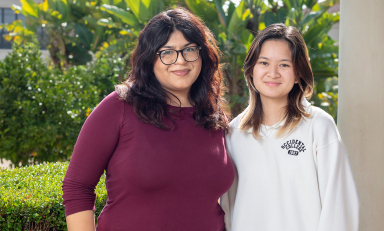Oxy soccer roars back into action—and the Tigers are in the hunt for goals and glory
In the early 21st century—when Colm McFeely was pulling double duty as coach of the men’s and women’s soccer teams at Occidental—coaching two squads in two locations on game day required the timing of a well-placed corner kick.
“I remember one time having the men's game on the grass field at Oxy with a 4 o’clock kickoff, leaving that 10 minutes before halftime, and driving to Claremont and getting to the women's game 25 minutes before the end of the game,” he says. “My assistant was there, but occasionally we were doing wild stuff like that. We tried to arrange for doubleheaders when we could.”
McFeely, who joined the Oxy soccer program in 1992 as a part-time assistant to Costa Nicolaou, has seen the highs and lows of the orange and black over 28 years on the sidelines. As the program’s first full-time coach in 2002, he steered both teams over the next six seasons to varying degrees of success.
The women broke through in the 2007 season, soaring to a 9-3 conference record (11-5-1 overall), finishing second and advancing to the first-ever SCIAC postseason tournament. That same year, Jesi Sasaki ’11 became the first frosh to be named conference player of the year in the history of SCIAC women’s soccer.
It would take the men a few years to catch up to that measure of success, but in 2012, under third-year head coach Radames "Rod" Lafaurie, the Tigers notched the program’s first winning season in 24 years. Over the last six seasons, his squads have gone 67-40-10 overall, and the team's .608 conference winning percentage trails only Redlands (.778) and Chapman (.636).
“The transformation that we’ve seen here at Oxy has been quite phenomenal,” says Lafaurie, whose 11th year with the Tigers may be his most ambitious yet. Scheduled to travel to San Antonio, Texas, over Labor Day Weekend, Oxy will play three games in four days against some of the toughest competition in the West. After that the Tigers will host two-time defending Southern Athletic Association champions Birmingham-Southern on September 12 before kicking off the conference schedule three days later.
Coming off a 2018 season in which Oxy placed second in the regular-season standings and lost the SCIAC tournament championship on its home turf to Chapman, the men finished fourth in the regular season in 2019 with a SCIAC record of 7-4-1 (10-6-4 overall). After 53 years of conference play, a conference title has eluded the men’s squad.
For the women, who likewise finished 7-4-1 in SCIAC (11-5-1 overall) in 2019, a return to the SCIAC Postseason Tournament in November seems likely. Since 2007, Occidental has qualified for the postseason six times, advanced to the finals four times, and won the tournament in 2018. But McFeely remembers a number of other years where the Tigers missed the postseason by a single point—and that’s something he feels the team can work on.
“What can we do collectively—physically, but probably more mentally—when that last game comes and not be too overly concerned about it?” he asks. “What can we do to get over that little bit and then make that a consistent theme as we go forward?”
After a year without athletics, both coaches expect good things out of Oxy soccer this fall. “We're returning a large chunk of a group that was in the playoffs in 2019,” Lafaurie says of his players. “More than anything else, they will at least be hungry and do what they can to be in that hunt for a championship.”
“There’s no reason why we don't look at the opportunity to win a conference championship again,” McFeely says of the women’s squad. “Rod’s done a good job with the men as well, and I think we're both now competitive and respected. And the next step is to be feared.”
While soccer has had a foothold since the 1950s at a number of Oxy’s traditional rivals, including Caltech and Pomona, it wasn’t until 1965 that the Tigers fielded their first men’s soccer team. Coached by Mike Holmes ’58, who played football while at Oxy, the Tigers went 4-5-3 in its inaugural season, competing in the Southern California Soccer Association (with the likes of Biola, Cal State Fullerton, Caltech, Chapman, Loyola Marymount, Pomona, Redlands, UCLA, UC Riverside, UC Santa Barbara, USC, and Westmont).
On November 6, 1965, the team put on a halftime exhibition with Redlands during the Tigers football team’s Homecoming contest with the Bulldogs. “Play was fast and furious with the crowd responding enthusiastically to a sport that many had never seen before,” goalkeeper John Vogel ’66 wrote in The Occidental.
“It was meant to divert the audience between the end of the first half and the beginning of the second half, nothing more,” recalls Vogel, who enrolled at Oxy from Phillips Academy in Andover, Mass. “Redlands did not have a full team, but they had enough to be able to do something. It wasn't serious, but in terms of being able to get out on the field with a real audience for the first time, it was a lot of fun.”
Men’s soccer was elevated to varsity status in 1967, and SCIAC play began with six teams: Occidental, Caltech, Claremont-Mudd, Pomona, Redlands, and Whittier. “Our games were on Anderson Field, with the exception of the last game of the 1969 season, an 8-0 victory over Whittier under the lights on Patterson Field,” recalls Geoff Cocks ’70, who played on the varsity from 1967 to 1969 and would return to coach the Tigers in the 1971 and ’72 seasons.
Cocks played under Jim Perino (Oxy’s equipment room manager) that first year, and local businessman Brian Gilhooley in 1968 and 1969. Gilhooley and his assistant, John Terry, both were associated with the Shamrock Rovers of the Greater Los Angeles Soccer League, for which a number of Tigers subsequently played.
“We all liked each other and the experienced and skillful international players were patient and effective role models,” Cocks says. “We also felt that we had to prove that soccer was a worthy program alongside the football, basketball, and fabled Occidental track and cross country teams.”
As a coach, Cocks’ squads went 5-6-1 in 1971 and 7-2-4 in 1972 (the latter good enough for second in the SCIAC). “I had a close relationship with the players I coached, largely because I was only a bit older than they were and had played alongside some of them at Oxy,” he recalls.
In 1975 Cocks was hired as a professor of history at Albion College in Michigan and coached Division III soccer for five years. He played club and intramural soccer in Michigan until retiring to Carmel in 2016. “I enjoyed learning the game at Occidental, although the level of play and coaching then was nowhere near as high as it has since become,” he says. “But we felt we were pioneers—and, for me, the game has been a lifelong companion.”
When women’s soccer got its start at Oxy as a club sport in 1979, a good practice space was hard to find. “We would just go kick the ball on grass in front of Thorne Hall or wherever,” recalls Karen (Modafferi) Browning ’87, who played two years of the club sport before women’s soccer attained varsity status in 1985.
“That was quite an accomplishment,” she adds. “We were really excited to be recognized and that those hard years paid off in terms of playing at the club level and finally being recognized as a varsity sport.” A mathematics major at Oxy, she teaches high school math in Mattapoisett, Mass. “Kids today don't realize that people had to pave the way so that there were the same number of women's sports as men’s sports in schools.”
SCIAC women’s play began with four teams: Occidental, Pomona-Pitzer, Claremont-Mudd-Scripps, and Redlands. (Whittier joined the following year.) The women finished 2-4 in conference play and 3-8-1 overall. “We had a lot of close games,” Browning recalls. “I think we were all out there because we just loved the game. Obviously, you want to win, but it was more about playing and being part of a team.”
The team’s founding coach was Brian Williams ’85, a psychology and physical education double major, who came to Oxy to play soccer and baseball. “The facilities for soccer at that time were not good,” recalls Williams, who is now director of facilities at his high school alma mater, the Bishop’s School in San Diego. “We practiced out on Bell Field [which has since been renovated and enlarged as a softball field], and played our games in the outfield at the baseball field [Anderson Field]. Maybe once or twice a year, we got to play on the football field.”
Williams coached the team for two years before moving over to the men’s team for a single season. His successor as women’s coach? Karen Browning. (She even met her husband, John Browning ’86, on the soccer field. “He played soccer, too. He graduated a year ahead of me and we've coached our kids. I would say soccer is in our blood.”)
Hampered by limited resources and diminished enrollment numbers (a combination that would impact many of the College’s most storied athletics programs), Occidental soccer nonetheless saw a few bright spots in the 1990s. The women’s team handed Cal Lutheran its first loss in four seasons and 47 matches of SCIAC play in October 1994 on a game-winning goal by Jocelyn Ferialdi ’98, capping a 3-2 road victory over the Regals. That same year, men’s soccer went 7-8-2 overall, notching more wins than in the previous four seasons combined. Leading the way was second-team All-SCIAC pick Trevor Moawad ’95 M’96, who earned All-American and first-team All-SCIAC honors as a senior.
At its nadir, women’s soccer went 0-17 in 2001 (after winning one match the previous season), and new athletic director Dixon Farmer ’63 was looking to take the soccer programs in a different direction. Nicolaou parted ways with Oxy, and the search was on for a full-time men’s and women’s coach. Given the opportunity, McFeely impressed Farmer during the interview process with his vision for the program and was offered the full-time role.
In 2008, after six years running both programs, McFeely (in his new role as soccer coordinator) handed the men’s team off to D’Angelo J. “DJ” Waddington, who spent two years as an assistant coach with the Tigers. His style of coaching immediately clicked with his players: “We have some tough games ahead of us, but if we play well together we should be able to make the playoffs,” first-year goalie Andrew Larkin ’12 told The Occidental midway through the season.
That prophecy didn’t materialize, and Waddington left after a second disappointing campaign in 2009. Larkin alerted his old eighth-grade coach about the men’s soccer opening at Oxy. “Part of my experience was making a positive impact in Andrew’s life, and so he ended up attending Occidental,” recalls Lafaurie, who played Division I soccer as a goalkeeper at Cal State Northridge. (He subsequently trained with the Los Angeles Galaxy as a reserve for a season under Coach Steve Sampson and followed that up with a two-year stint in the Premier Development League.)
When Lafaurie arrived, Oxy was coming off a 4-12-1 season, including a road loss to perennial doormat Caltech. “We were fighting for the bottom,” he says. “It wasn't for lack of effort and it wasn't for lack of quality. When I got here, the boys were fantastic.”
Lafaurie’s early years at Oxy had more ups and downs than a share of GameStop. Following the highs of 2012 (8-8 SCIAC, 9-8 overall), “I thought, ‘OK, we kind of figured this thing out, we got this. In 2013, we even won our first game of the season [vs. UC Santa Cruz], 4-0. And then BOOM.” Oxy went 2-16 the rest of the season, with its only wins coming against (you guessed it) Caltech.
Looking back, Lafaurie says, “Probably the most successful year I ever had was 2013. That was when I had to double down on the culture of what it really means to be a student athlete and what define success.”
After that season, “I was ready to climb under a rock,” Lafaurie says. Instead, he reached out to some of the most successful coaches in Division III soccer—including Paul McGinlay at Trinity University and Dave Brandt at Messiah—to pick their minds about building a successful program. He then spent the winter putting together a book about things that are important to Oxy’s program: “What do we want to see out of our men? What are the controllable things that we can take care of? What are the targets that we want to hit? At that point, it was like a 12- or 13-page document,” he says. “Now that document is 90 pages.”
That spring, Lafaurie—who was living in a College-owned property near Oxy—invited his players over for a barbecue. He showed them the book and talked to them about team goals. “There are always a couple of players that are a little hesitant, because it's harder,” he says. “I want people who want the challenges, who want to grow—who understand that without challenges you won't grow.” The following season, the Tigers went 10-5-1 in the SCIAC to make the playoffs as the No. 4 seed.
In building a program that is poised to contend for SCIAC championship and postseason success in the Western Region, Lafaurie has mustered support in the Oxy community as well. In the most recent Day For Oxy, men’s soccer led all sports with $40,070 in support from 60 donors. Women’s soccer raised an additional $13,968 (ninth among all sports) from 51 donors.
In the case of the men, that support will underwrite the four-day trip to San Antonio that includes matchups with Southwestern University (which made the NCAA tournament in 2018), Willamette (which won the Northwest Conference in 2020-21), and host team and NCAA perennial Trinity. That match will bring Lafaurie face to face with his mentor, McGinlay, who ranks among the five winningest coaches in Division III history. “If you’re going to make an NCAA tournament, you have to go through Trinity in the West, so I hope we'll see them twice this year.” Lafaurie says. “We have a very challenging set of games in Texas and I wouldn’t have it any other way.”
Abilene, Texas, was the setting for the biggest game in the history of Oxy women’s soccer. On November 10, 2018, the Tigers went toe-to-toe with the Trinity women’s squad, having beaten Pomona-Pitzer in a penalty shootout one week earlier to win its first (and to date, only) SCIAC tournament championship.
But on this day, Oxy came up on the short end of a 1-0 contest against No. 13 Trinity. “We gave the 13th-ranked team in the country a scare,” McFeely said after the game. “We had a few chances and had we put one away, we could have had a different outcome.”
Looking back now, McFeely says, “With a bit more experience, maybe we could have beat that team. But this is how you get better—by competing and performing at the highest level.” One of his team leaders this year, a rising junior, has her eyes set on a national championship ring before leaving Oxy. "It’s vital to set goals and this is the mentality that we need to be competing with the top half of SCIAC and leave it all out there," he says. "If we have a bad game, we have to look and say, ‘Was that us? Or did we meet a better team?’ And as coaches, we have to critique ourselves as well: Did we not set up the training the day before the game the right way?”
If there’s one lesson McFeely has taken from his players, it’s to give them the reins to grab the game and take care of business on the field (“as tough as it is at times,” he admits with a laugh). “I want them to have the autonomy to survey the game and make decisions. As soon as they get the ball, look forward. You hurt teams by penetration—it could be five yards, it could be a dribble. This is a player’s game. It's not a ‘Time out: We’re doing this run.’ I want them to grab the game.” And if they do, he says, “Maybe eventually one day I will be sitting on the bench saying nothing.”

